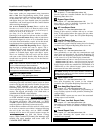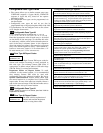
Configurable Zone Type Charts
ENTRY 1 ENTRY 2
Response when system disarmed and zone is:
Intact EOL
RF zone normal
Open
RF zone N/A
Shorted
RF zn off-normal
Auto
Restore
Vent Zone
0 = normal
1 = alarm
2 = trouble
3 = fault
0 = normal
4 = alarm
8 = trouble
12 = fault
see note 5
0 = normal
1 = alarm
2 = trouble
3 = fault
see note 6
0 = no
4 = yes
0 = no
8 = yes
Entry 1 = EOL + Open Entry 2 = Short + auto restore + vent zone
ENTRY 3 ENTRY 4
Response when armed STAY and zone is:
Intact EOL
RF zone normal
Open
RF zone N/A
Shorted
RF zn off-normal
Byp. when
disarmed
Byp. when
armed
0 = normal
1 = alarm
2 = trouble
3 = fault
0 = normal
4 = alarm
8 = trouble
12 = fault
see note 5
0 = normal
1 = alarm
2 = trouble
3 = fault
see note 6
0 = no
4 = yes
0 = no
8 = yes
Entry 3 = EOL + Open Entry 4 = Short + byp. disarmed + byp. armed
ENTRY 5 ENTRY 6
Response when armed AWAY and zone is:
Intact EOL
RF zone normal
Open
RF zone N/A
Shorted
RF zn off-normal
Dial Delay
(see field *50)
Fault Delay
(see field *87)
0 = normal
1 = alarm
2 = trouble
3 = fault
0 = normal
4 = alarm
8 = trouble
12 = fault
see note 5
0 = normal
1 = alarm
2 = trouble
3 = fault
see note 6
0 = no
4 = use delay
0 = no
8 = use delay
see note 1
Entry 5 = EOL + Open Entry 6 = Short + dial delay + fault delay
ENTRY 7 ENTRY 8
Display Faults Power Reset/
Verification
Use Entry
Delay 1/2
Use Exit
Delay
Respond as
Interior Type
0 = show alarms
when armed
& disarmed
1 = don’t show
alarms when
armed
(show
alarms, trbles,
faults when
disarmed)
3 = never show
any alarms,
trbles, faults
0 = no
4 = power reset
after fault
(with code +
OFF)
12 = verification
(see zone
type 16)
0 = no
1 = delay 1
2 = delay 2
0 = no
4 = use exit
delay
0 = no
8 = yes
see note 2
Entry 7 = fault display + power
reset/verification
Entry 8 = entry delay 1/entry delay 2 + exit delay +
interior zone type
ENTRY 9 ENTRY 10
Alarm Sounds Use Bell
Timeout
Respond as
Fire Zone
Trouble
Sounds
Chime when Chime
Mode On
0 = none
1 = steady
keypad
2 = steady bell
and keypad
3 = pulsing bell
and keypad
0 = no
4 = yes
see fields *32,
*33
0 = no
8 = yes
see zone type
09; see note 4
0 = none
1 = periodic
beep
2 = trouble
beeps
0 = no
4 = yes
Entry 9 = alarm sounds + bell timeout + fire zone Entry 10 = trouble sounds + chime
OPEN SHORTEDINTACT
EOL
ZONE-003-V0
Zone Conditions Represented
in Entries 1-6
Configurable Zone Type Notes
1. Do not use the “fault delay” option
with a configurable zone type if it
is set for an entry or exit delay,
otherwise unpredictable results
may occur.
2. To create an interior type zone,
select “respond as interior zone
type” (entry 8, interior type = yes),
and set zone response to “fault” in
entries 3-4 to ensure fault
displays; do not set as “normal,”
“alarm,” or “trouble.”
3. Do not set fire zones to respond as
a “fault” (entries 1-6), otherwise
faults will not display unless the
[∗] key is pressed.
4. 4219/4229 modules must use
EOLRs or unpredictable results
may occur.
5. RF Zones: The “open” options in
entries 1, 3, and 5 are not
applicable for RF zones. Use the
“intact EOL” option for normal RF
zone conditions and “shorted” for
off-normal RF zone conditions.
6. a. Zone-Doubling/Double-
Balanced: A short on either
zone of a zone-doubled pair or
on a double-balanced zone
causes a tamper condition.
b. For double-balanced zones, this
entry must be “0”.
c. For zone-doubled zones, both
zones of the doubled pair must
be assigned the same response
to a short.
Installation and Setup Guide
4-10


















